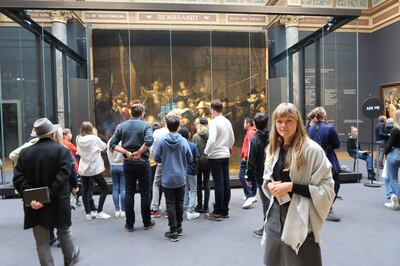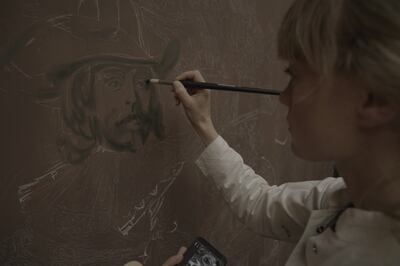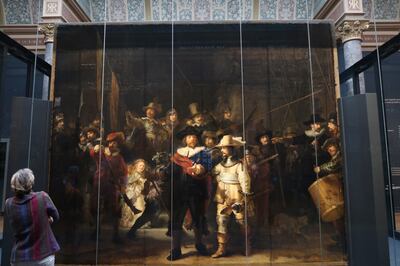Ever looked at a classic painting and asked yourself with astonishment: “How did the painter do it?” Dutch painter and art historian Lisa Wiersma knows the answer to that question when it comes to Dutch masterpieces.
After all, her recreation of Johannes Vermeer's The Milkmaid (c.1660) made none less than the director of the Rijksmuseum hesitate for a moment when asked which one was Vermeer’s and which one hers.
Wiersma has recreated Vermeer’s masterpiece, alongside eight others, in under two years for the Dutch TV show Masterpiece. The programme is dedicated to giving its audience the opportunity to witness as accurately as possible how famous Dutch masterpieces have been created, using the original techniques and even old paint ingredients where possible.
For the fifth season of the show, which airs in the Netherlands on January 25, Wiersma, 36, has undertaken the challenge of recreating the jewel on the Dutch Golden Age’s crown: Rembrandt’s The Night Watch (c.1642), in its full, original size.
A star is born
Wiersma had not recreated an entire painting before participating in the show. In fact, it wasn’t until her late 20s that she started using oil paint.

A drawing enthusiast since her childhood, she joined the Art Academy in Amsterdam after graduating from high school. Her journey with the Academy was short lived, however.
“I wanted to learn how to paint with oil paint, but was told at the Academy that it was way too difficult, and that they will not teach it. It wasn’t a classical but rather a very conceptual art academy, so I should have seen that one coming,” Wiersma laughs as she recalls, “Six months later, I quit.”
Realising how detached she was from contemporary art, she decided at that point that she no longer wanted to become an artist. Trying to figure out her next move, she joined the University of Amsterdam (UvA) to study art history.
“I was reluctant to take this step because it was indeed a quite theoretical track, and I wondered if I should still be engaging with art at all, or if there was something else for me.”
Luckily for young Wiersma, around the time that she started her graduate studies, technical art history was gaining popularity at her alma mater. In 2009, her life took a turn when a professor at UvA asked her to assist him in teaching a new technical art history course. He also referred her to a painter, who gave her painting lessons.
“That’s how I hopped on the technical art history’s train,” she says. “It was the point when I dared to admit that I wanted to become an artist, after believing for years that the contemporary art world is very different from what I do and what I am interested in.”
'I knew I'd hate myself for doing it'
When she was approached to be the lead painter of The Secret of the Master in 2020, Wiersma was researching how fruits, particularly grapes, were painted in the 17th century.
“I had been too busy painting grapes for a while at the time,” she says. “I chose this topic for my PhD thesis because grapes are one of the most complex paintings of the 17th century, as they required nine layers of paint: a ground colour, a reflection of light, a refraction of light in the translucent grape, the gloss, the haziness in it, and others.”

With this meticulous attention to technique, the art historian and researcher didn’t hesitate to accept the opportunity of recreating masterpieces on a full-time basis for the show.
“By recreating the fantastic paintings that the public loves, we can really answer the question, 'how did a master manage to achieve this?'
In 2020, she recreated eight famous works by Dutch artists from different eras, working on several of them simultaneously. Undoubtedly, Bruegel’s Tower of Babel (c.1568) was one of the most challenging to recreate among them.
“Doing this, you learn that drawing a painting doesn’t necessarily have to take months or years ... you do it layer by layer, letting each layer rest and dry, which might take a week or more per layer. This way, you can work on more than one painting at a time.”
When the producers of the show approached Wiersma in 2021 to recreate Rembrandt’s most famous work, which depicts an Amsterdam militia marching through the city, she knew what to expect and demanded a team to help her from the first day.
“I knew in advance that I would hate myself for doing it,” she says, laughing, “but I am a naive optimist so I always start with ‘yeah, let’s try’ and then always a point comes where I feel overwhelmed, especially with The Night Watch.”
The kindness of the artist
To Wiersma’s good luck, Dutch masters of the 17th century kept records of their artworks' processes and paint recipes.
“The instructions of the masters are really helpful and that is the reason it’s nice to be an art historian. When you want to paint in the old-fashioned way, you know where to look and what to look for.”
However, recreating The Night Watchwasn't without its challenges. After all, there was a lot of pressure on the painter to produce something that lives up to what is arguably the most famous work by a Dutch painter.

“To make such a big piece did require a lot of creativity from Rembrandt,” says the Dutch painter. “He also had to figure out the best way to create a group portrait, which is an otherwise usually extremely dull genre of painting.”
The outcome was an interesting, original piece, where, says Wiersma, Rembrandt “touched upon each face to make it likeable” with extreme kindness.
Another challenge that Wiersma had to overcome was synching the work of four other painters, ensuring that they all mimic Rembrandt’s style.
“I’ve never led an atelier before, and it was really difficult to run a workshop and agree on things,” she adds. “Initially, we agreed to work separately, but gradually I realised that it was better if I got more controlling because otherwise you would end up with patches drawn in different styles.”
What next for all the replicas?
In 1715, the original painting by Rembrandt was trimmed from all four sides to fit on a wall in the Royal Palace on Dam Square in Amsterdam. This means that upon its completion in October, Wiersma’s replica was larger than the original hanging at the Rijksmuseum in Amsterdam.
But to what extent is Wiersma satisfied with the final outcome?
“When recreating, there is always a point where you feel that you’re getting somewhere but still accept that you’re never done. When you look at those paintings up close in real life and not on TV, you will always find something not sufficiently detailed or missing.”
Wiersma has accepted the fact that a precise recreation requires an unachievable level of attention to detail, but believes that as science and research advance, recreations will only become better in the future.
“In a few years, we can make a more accurate copy but I don’t think I'll be the one to redraw it then,” she says, relieved, with a laugh.





